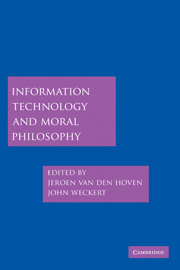Book contents
- Frontmatter
- Contents
- List of Contributors
- Introduction
- 1 Norbert Wiener and the Rise of Information Ethics
- 2 Why We Need Better Ethics for Emerging Technologies
- 3 Information Ethics: Its Nature and Scope
- 4 The Transformation of the Public Sphere: Political Authority, Communicative Freedom, and Internet Publics
- 5 Democracy and the Internet
- 6 The Social Epistemology of Blogging
- 7 Plural Selves and Relational Identity: Intimacy and Privacy Online
- 8 Identity and Information Technology
- 9 Trust, Reliance, and the Internet
- 10 Esteem, Identifiability, and the Internet
- 11 Culture and Global Networks: Hope for a Global Ethics?
- 12 Collective Responsibility and Information and Communication Technology
- 13 Computers as Surrogate Agents
- 14 Moral Philosophy, Information Technology, and Copyright: The Grokster Case
- 15 Information Technology, Privacy, and the Protection of Personal Data
- 16 Embodying Values in Technology: Theory and Practice
- 17 Information Technology Research Ethics
- 18 Distributive Justice and the Value of Information: A (Broadly) Rawlsian Approach
- Select Bibliography
- Index
- References
15 - Information Technology, Privacy, and the Protection of Personal Data
Published online by Cambridge University Press: 21 July 2009
- Frontmatter
- Contents
- List of Contributors
- Introduction
- 1 Norbert Wiener and the Rise of Information Ethics
- 2 Why We Need Better Ethics for Emerging Technologies
- 3 Information Ethics: Its Nature and Scope
- 4 The Transformation of the Public Sphere: Political Authority, Communicative Freedom, and Internet Publics
- 5 Democracy and the Internet
- 6 The Social Epistemology of Blogging
- 7 Plural Selves and Relational Identity: Intimacy and Privacy Online
- 8 Identity and Information Technology
- 9 Trust, Reliance, and the Internet
- 10 Esteem, Identifiability, and the Internet
- 11 Culture and Global Networks: Hope for a Global Ethics?
- 12 Collective Responsibility and Information and Communication Technology
- 13 Computers as Surrogate Agents
- 14 Moral Philosophy, Information Technology, and Copyright: The Grokster Case
- 15 Information Technology, Privacy, and the Protection of Personal Data
- 16 Embodying Values in Technology: Theory and Practice
- 17 Information Technology Research Ethics
- 18 Distributive Justice and the Value of Information: A (Broadly) Rawlsian Approach
- Select Bibliography
- Index
- References
Summary
Information technology allows us to generate, store, and process huge quantities of data. Search engines, satellites, sensor networks, scientists, security agencies, marketers, and database managers are processing terabytes of data per day. A good part of these data are about persons – about their characteristics, their thoughts, their movements, behaviour, communications, and preferences – or they can be used to produce such data. All countries and cultures in the present and past have constrained access to certain types of personal data in some way or the other (see Moore 1984). There are etiquettes, customs, artefacts, technologies, or laws, and combinations thereof, which prevent or proscribe against the use or dissemination of personal information. Walls, curtains, doors, veils, sealed envelopes, sunglasses, clothes, locked cabinets, privacy laws, secure databases, cryptographic keys, and passwords all serve the purpose of preventing individual persons to acquire and use information about other persons. The issues are often discussed in the context of a specific social sector or professional domain, such as health care, social or homeland security, search engines, marketing, or policing. More specifically the issues can be concerned with camera surveillance, the monitoring of Internet communications, the retention of Internet traffic data, the disclosure of passenger lists to security agencies, the availability of individual medical information in the public health system, the linking and matching of databases in social security to detect fraud, and sifting and trawling through financial databases in order to find suspect transactions.
- Type
- Chapter
- Information
- Information Technology and Moral Philosophy , pp. 301 - 321Publisher: Cambridge University PressPrint publication year: 2008
References
- 38
- Cited by



